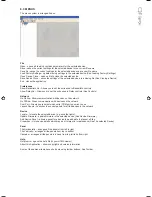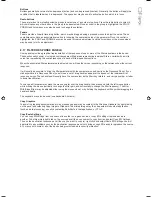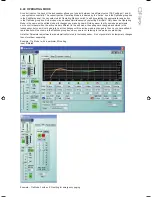
Protection
Comprehensive protection features preserve the longevity of the amplifiers and drivers by continuously monitoring
several critical parameters, and reducing the gain, or muting the amplifiers either temporarily or permanently depending
on the nature and seriousness of the fault or misuse. The amplifiers will recover and restart if at all possible, but may
remain shutdown if a serious fault persists.
Limiters deal with routine over-driving of the drivers, making sure that the drivers are not pushed too hard.
Minor faults are dealt with by slowly ‘dimming’ the loudspeaker, reducing the level to a sufficient degree and for a
sufficient time that the amplifiers are able to recover gracefully without any user interaction. When the fault condition has
passed, the amplifiers will slowly fade up to normal.
More serious faults may cause the amplifiers to mute while they recover, after which they will automatically re-energise
and fade up, again without user interaction. If such a fault is found to be persistent however, the amplifiers may shut
down permanently, flashing an indicator rapidly. A power cycle by the user is then required.
During power-up, the amplifiers will remain muted for a short time while checks are made that all is well. During this time,
the Indicator will flash. The signal is then gently faded up.
Indication
Visible from the front of the loudspeaker is a Network indicator, which also winks for a few seconds when the ‘Locate’
feature is activated in PodWare. This allows you to confirm which control panel in PodWare is dealing with which physical
loudspeaker.
Summary of indication:
During Loudspeaker power-up: Indicator winks rapidly
Loudspeaker has detected a fault: Indicator winks rapidly
Locate feature activated in PodWare: Indicator winks
Mute All activated: Indicator winks slowly
8.23 DEVICE PROPERTIES
By selecting Device>Properties from the menu (see Menus), or by selecting Properties from the Device Context Menu
(see
Device Context Menu), a dialogue will be shown listing some properties for the selected device (See The Selected
Device
). These are as follows:
Model Name:
The Model Name/Number the type of device is usually known as (e.g. “QFlex 16 Master”)
Device Name
: The name given to this particular device by the user (e.g. “Left Proscenium”).This can usually be changed
in a control panel, or in the Device Context Menu (seeDevice Context Menu)
Settings Name:
The name given to the current set of parameter settings (e.g. “Bright vocal”)
Firmware Model
: A number describing the type of software running in the device.
Firmware Version:
The version number of the firmware so you can tell if you have the latest. See
Device Firmware
Handle:
A 4-digit hexadecimal number which will uniquely identify this device on a network
Link Address:
A hexadecimal number which the network will use for addressing this device.
Hardware Version: A number representing a variant of the hardware build of a given device type. This is rarely of
concern to the user, but you may be asked to quote this value when discussing a problem with your dealer.
When you have finished with the dialogue, just click the Done button.
Summary of Contents for Qflex
Page 1: ...u s e r m a n u a l...
Page 34: ...Input A muted...






























